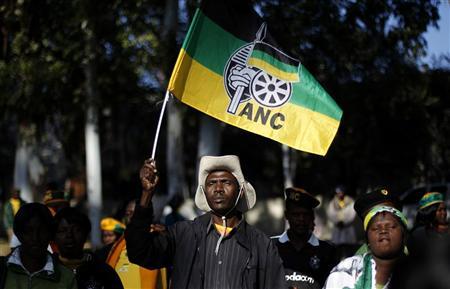(Reuters) – First graders huddle to do sums on scraps of paper pressed against a cracked mud wall at Mwezeni Primary School in South Africa’s destitute Eastern Cape province.

The school may be located in Africa’s wealthiest nation, but there are no chairs, no desks and no work books.
The Eastern Cape, home to giants of the African National Congress like Nelson Mandela and Walter Sisulu who helped end apartheid and Thabo Mbeki, the nation’s second democratically elected president, is a glaring example of the ruling party’s failure to deliver its promise of a “better life for all”.
In Entshingeni village, not far away from where Mandela was raised, a mud hut with a dirt floor serves as a classroom to 79 first and second graders who sit on planks across rickety bench frames in front of a battered chalkboard.
“We are proud of Mr Mandela and Mr Mbeki. They came from this land and went all over the world. What will presidents overseas say if they see how we live?” said David Skwele from Mkanzini village, dressed in a tattered red T-shirt.
The ANC, in power now for 18 years, will hold a major policy conference from Tuesday next week acknowledging that “public services are uneven and often of poor quality; corruption is widespread; and South Africa remains a divided society”.
While thousands of schools wait each year for textbooks and many Eastern Cape children are forced to write on loose sheets, the ANC has produced copious reams of policy papers to be studied by about 3,000 delegates at next week’s meeting.
The conference is expected to lead to another blizzard of strategy documents on what the ANC calls a “second transition”.
This aims to tackle what the party acknowledges as its greatest unfinished business: spreading wealth more widely and equitably in a nation whose levels of economic inequality are still among the highest in the world, a legacy of the political compromises needed to dismantle apartheid, which ended in 1994.
“Continuing with the status quo could lead South Africa into an irreversible downward spiral … Our political transition was never only about freedom from political bondage,” an ANC discussion document prepared for the policy conference says. It refers to “old fissures of race, gender, class and geography”.
“GET RID OF THE ROT”
The week-long policy meeting is being held amid signs of acrimonious infighting among senior party figures ahead of another more critical conference at the end of the year which will elect the leadership and adopt strategies. President Jacob Zuma is widely expected to retain the party’s top job.
The ANC proposes government taking greater control of the economy, a massive infrastructure program to create jobs and taxing mining firms more to help finance it all.
But a jaded public expect few effective measures from the conference to tackle corruption, mismanagement and cronyism that analysts see corroding governance and competitiveness in Africa’s largest economy.
Party insiders insist that the ANC is aware it needs to get its house in order. This means balancing pressure from an increasingly demanding but still marginalized majority against the political clout wielded by a post-apartheid economic elite whose interests are intertwined with the ANC government.
“At 100 years, now is as good a time as any to get rid of the rot festering in the party,” said one party official, who asked not to be identified while discussing internal criticism the party tries to keep behind closed doors.
A new book on South Africa by journalists Martin Plaut and Paul Holden, titled “Who rules South Africa? Pulling the strings in the battle for power”, describes the country’s political, economic and social state as “schizophrenic and disjointed”.
“A wealthy now largely multiracial middle and upper class exists in a first world bubble that is miles away from the penury from a bottom half that has seen few gains from the post apartheid period,” they wrote.
“MOUSE IN A CHEESE FACTORY”
Education has always been a priority for the ANC and the government spends nearly $1,400 a year on each student. But at hundreds of Eastern Cape schools, it is difficult to see where any of the money has gone.
The classroom shack of the Mkanzini Junior School is so rickety that teachers fear that if they tack up charts on the rusted walls, the structure will collapse.
“On sunny days we boil in here. Look at the big holes, on rainy days we are soaked and on windy days, I am afraid the shack will fall on the kids,” said teacher Zoleka Nofonda, 40, who has two grades crammed in the room.
“They come because of the free meal we give them. Sometimes it’s the only thing they eat all day.”
The ANC, still revered for their role in bringing down apartheid, enjoys virtual one-party rule in South Africa.
In recent elections it has beaten the main opposition Democratic Alliance, largely seen as a party of white privilege in a nation that is 80 percent black, by more than 40 percentage points, although the opposition has made some gains.
Without fear of losing power, the ANC has deployed thousands of party cadres to run villages, towns and cities. But many of the movement’s loyalists have proved themselves more skilled at lining their pockets with state funds than at doing their jobs.
“It is like taking a mouse from the bush and making it run a cheese factory,” ANC Secretary General Gwede Mantashe told Reuters. He said the party was trying to rectify this.
LOST GENERATION
The delivery deficit is most acute in the Eastern Cape which receives the most funds of any province for welfare spending.
Spending here is pushed higher because the ANC government inherited sprawling “homelands”, which were set up by the apartheid regime to concentrate the black majority with almost no infrastructure in designated separate areas of the country.
With poverty so deep in Eastern Cape and a local electorate closely tied to the ANC, few have sought change through the ballot box so far. But other parts of the country saw 372 protests against poor public services between January and May.
“There is very little sophistication from civil society and the electorate to hold leaders accountable,” said Derek Luyt from an Eastern Cape think tank, the Public Service and Accountability Monitor.
The central government more than a year ago declared the province’s education system an abject failure, and said it would intervene. But entrenched interests in the provincial ANC defied the mother body and kept control of education purse strings.
This meant little improvement for Mwezeni Primary, one of 400 schools made of mud and sticks. More than 2,300 schools in the Eastern Cape have six teachers or less.
But according to government statistics, the Eastern Cape overspends on teachers by up to $120 million a year, and civil society activists suspect the money is going to corrupt officials instead of personnel in classrooms.
“Eastern Cape has a long history of inequality and poor bureaucracy inherited from the former homelands. It’s a province using old systems, where corruption and mismanagement thrives,” said Yoliswa Dwane from the Equal Education advocacy group.
Nearly half of South Africa’s 18 to 24 year olds – the first generation educated after apartheid – are not in the education system and have no jobs, according to government data.
This “lost” generation is seen as a weakness in Africa’s largest economy which is trying to grow its tax base as it funds increased social spending.
‘GHOST’ WORKERS, REAL SHORTAGES
As in education, corruption is also seen eating away at resources needed to boost the health sector. Horror stories of the Eastern Cape’s health woes have become a staple of media.
In May, an elite body set up to investigate corruption in the provincial government uncovered suspected graft amounting to $24 million.
In 2011, the provincial health department said nearly $100 million had “vanished” from January 2009 to June 2010 with about $54 million going to so-called ‘ghost staff’ who drew a paycheck and did no work, the regional Daily Dispatch reported.
Heading towards the sea on a rugged track lies Madwaleni Hospital, built by missionaries in the 1960s and staffed by foreigners because even lucrative stipends offered by the government have not proved enough to attract South African doctors.
“We are always experiencing a shortage of something. Sometimes it is medicine, sometimes it is gloves but our worst is a shortage of doctors and nurses,” said a foreign doctor who did not want to be identified while discussing the hospital’s shortcomings.
Human Rights Watch said in a 2011 survey that Eastern Cape had some of the worst health indicators in South Africa, including high infant, child, and maternal mortality rates.
Nofinish Nqata, 63, lives in a traditional white-washed Xhosa hut in Ngqamakhwe village in Butterworth, on land allocated to her by the local chief.
The village has no electricity or telephones. Families use pit latrines and walk long distances to collect water.
“The water we drink we share with pigs, cows and donkeys. Some people use the river banks as their toilets and when it rains it washes into the water supply.”
Once a die-hard ANC loyalist, Nqata has taken the bold step of joining the Democratic Alliance.
“It hurts so much because the old men Sisulu and (former ANC president Oliver) Tambo are no longer alive and the ones who took over the baton don’t share the vision the stalwarts who fought for democracy had. They care about themselves and their pockets, not us.” ($1 = 8.2215 South African rand)
(Editing by Jon Herskovitz, Pascal Fletcher and Peter Graff)





